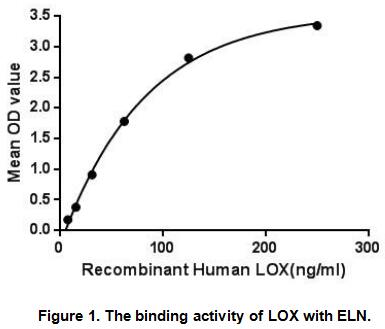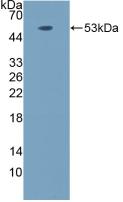
Details
ACTIVITY TEST
Buffer Formulation 20mM Tris, 150mM NaCl, pH8.0, containing 1mM EDTA, 1mM DTT, 0.01% SKL, 5% Trehalose and Proclin300. Traits Freeze-dried powder Purity > 90% Isoelectric Point 6.2 Applications Cell culture; Activity Assays.

Lysyl oxidase (LOX) also known as protein-lysine 6-oxidase is an extracellular copper-dependent enzyme that catalyzes formation of aldehydes from lysine residues in collagen and elastin precursors. Its catalytic activity depends upon both its copper cofactor and a unique carbonyl cofactor and has been shown to extend to a variety of basic globular proteins, including histone H1. LOX plays a major role in connective tissue development and may also be important in neurological function. Lysyl oxidase has also proven crucial to the development of the respiratory system and the skin, the commitment step of adipocyte, and the formation of pluripotent stem cells during development. Its absence may lead to defects in the transforming growth factor beta superfamily of proteins, which control cell growth and differentiation. Besides, Elastin (ELN) has been identified as an interactor of LOX, thus a binding ELISA assay was conducted to detect the interaction of recombinant human LOX and recombinant human ELN. Briefly, LOX were diluted serially in PBS, with 0.01% BSA (pH 7.4). Duplicate samples of 100uL were then transferred to ELN-coated microtiter wells and incubated for 2h at 37℃. Wells were washed with PBST and incubated for 1h with anti-LOX pAb, then aspirated and washed 3 times. After incubation with HRP labelled secondary antibody, wells were aspirated and washed 3 times. With the addition of substrate solution, wells were incubated 15-25 minutes at 37℃. Finally, add 50µL stop solution to the wells and read at 450nm immediately. The binding activity of LOX and ELN was shown in Figure 1, and this effect was in a dose dependent manner.
USAGE
Reconstitute in 20mM Tris, 150mM NaCl (pH8.0) to a concentration of 0.1-1.0 mg/mL. Do not vortex.
STORAGE
Avoid repeated freeze/thaw cycles. Store at 2-8°C for one month. Aliquot and store at -80°C for 12 months.
STABILITY
The thermal stability is described by the loss rate. The loss rate was determined by accelerated thermal degradation test, that is, incubate the protein at 37°C for 48h, and no obvious degradation and precipitation were observed. The loss rate is less than 5% within the expiration date under appropriate storage condition.
Image

SDS-PAGE Image

Figure. Western Blot; Sample: Recombinant LOX, Human.
Partial purchase records(bought amounts latest0)
User Comment(Total0User Comment Num)
- No comment


 +86 571 56623320
+86 571 56623320




